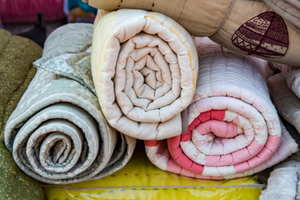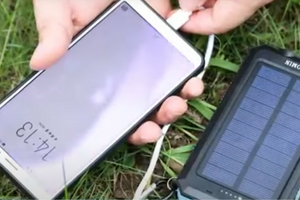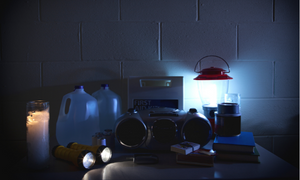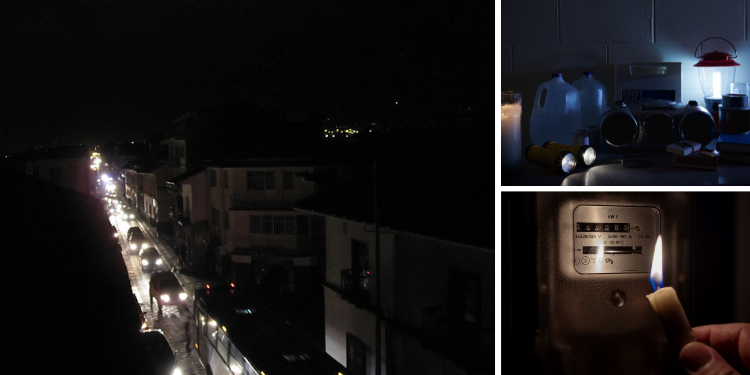Humans have lived without electricity for longer than we have had it in our lives. In fact, we survived the trials and tribulations of life just fine without the modern convenience of the electrical grid.
The problem is that so much of our lives are governed by our ability to access this resource that it can be more than a minor inconvenience when it fails.
Why Have A Blackout Survival Kit?
If we lived happy and fulfilled lives before the widespread adoption of electricity, why would we need to have a blackout survival kit? The answer is that the absence of electricity creates several problems for us that our ancestors had non-electrical solutions for.
Related: How to Build an Endless Hot Water System (Without Electricity)
Heating, cooling, refrigeration, lighting, and communications depend on electrical power; when the grid fails, we need to have some alternate means to accomplish these things.
Even though we can do just fine without a blackout survival kit, it makes sense to keep a collection of items set aside in a dedicated kit to help us when the power goes out.
What To Put In Your DIY Blackout Survival Kit
Your blackout survival kit should contain some key components that will return life to a sense of normalcy during a blackout. All of these should be in addition to our regular food, water, and other supplies.
Your considerations are going to be:
- Keeping warm/cool
- Keeping food cold
- Charging devices
- Lighting
- Communication
- Cooking
 Keeping warm/cool – We need power to run our furnaces and air-conditioning, and our blackout survival kit is not going to be able to have the ability to cool our home down.
Keeping warm/cool – We need power to run our furnaces and air-conditioning, and our blackout survival kit is not going to be able to have the ability to cool our home down.
Still, we can include blankets to warm ourselves up if the blackout happens in winter.
Keeping food cold – Aside from keeping our refrigerator and freezers closed when we do not need to get access to the food inside, we are going to need some other ways to keep our food from spoiling.
⇒ 5 Ingenious Ways To Refrigerate Your Food Without Electricity
The best way to do this is to have a generator or solar battery bank ready to run our refrigerators and freezers. You can also have blankets or other insulating material to wrap fridges and freezers in to help keep them colder.
Lighting – One of the first things we reach for when the lights go out is a flashlight, and a blackout survival kit will need to have several flashlights, headlamps, and lanterns to keep your home lit during the blackout. My blackout kit has a headlamp and lantern for every family member.
 Charging devices – At the minimum, you should have several battery banks ready to provide at least a couple of charges per device.
Charging devices – At the minimum, you should have several battery banks ready to provide at least a couple of charges per device.
Ideally, a solar battery bank or solar generator is the best option because this can also be used for running a fridge or freezer.
Communication – The failure of the power grid will also take down portions of the communications infrastructure.
You should have a battery-operated radio to get updates from the local radio stations, but you should also have a corded phone that you can plug into the wall and does not require any batteries or power. Amateur radios are also good to have on hand if you are appropriately licensed.
Cooking – A lack of power should not drive us to rip open our MREs. A blackout survival kit should have a camp stove, manual can opener, and plenty of fuel.
An Example of a Blackout Kit List
Each family will be different and have unique ideas of how their blackout survival kits should look. The list here is based on what I like to have on hand in case of a blackout.
For Each Family Member
 Headlamp
Headlamp- Flashlight
- Lantern
- Spare Batteries
- Blankets
- Battery-operated radio
In The Main Blackout Survival Kit
- Extra lanterns and headlamps
- Spare batteries
- Blankets
- Ham radios
- Shortwave battery operated or hand crank radio
⇒ Click Here To Learn How To Communicate Off Grid In A Crisis
- Corded Telephone
- Camp stove and fuel
- Manual can opener
- Solar generator, solar battery bank with panels, or gas generator
- Battery banks for mobile phones and other devices
How To Store A Blackout Survival Kit
This style of kit is not a grab-and-go kit that must be kept in a bag we can grab in a hurry. Storing the kit’s contents in a cabinet or closet is an excellent way to keep the contents organized and contained. You can also spread the contents over several locations around the home to make things easier and more organized.
It can be a good idea to give each family member an individual kit to keep in their bedrooms with a flashlight, lantern, headlamp, spare batteries, and some blankets.
This way, everyone in the home will know exactly where to go to get their individual kits, and if the blackout happens in the dead of night, they will be able to get their light source squared away without having to go to another area of the house in the dark to find the blackout kit.
One important thing to note is that you should not store any battery-operated device with the batteries inside. If batteries are left inside of a device, there is a risk that the contacts will become corroded, or the batteries could leak.
Keep a set of batteries for each device taped to the side so that they are easily accessed in the dark. I like to place a flashlight that takes only one battery in each kit which is easy to load the battery into when the lights are off. Then I can use this light to install the batteries in the remaining devices.
A blackout is rarely a life-threatening SHTF situation, but that does not mean we should not be better prepared for a blackout. Even if a power outage lasts only a night or two, a blackout survival kit will make life easier without electricity.






















Rechargeable Walkies with a 5 mile min range are great to communicate on your property in case cell service goes out.
Also, Get a drone with a camera. Something with the ability to reach a good altitude. Something that can give you a birds eye view of what’s going on around your area (ie hoards of joggers, zombies, UN Mraps, etc) without actually having to run headlong into them.
Oh and don’t forget…A bunch of rechargeable 9v batteries to power your smoke detectors. And if you haven’t bought paper maps yet, you probably should. No GPS likely.
Just buy Bofangs
Cannister Butane stove (1 burner) are pretty efficient cookers. Come in a plastic case about 12″ square by 3″ tall and the canned fuel lasts quite a while.
A wheeled cooler with folded blankets and other contents for this kit is convenient. Might consider having a cold weather kit (blankets / winter clothing) vs. a summer time kit (tent / sleeping hammocks / bug net) so you are ready to go in any situation.
Best way to test this prep is to shut off your electric mains for a weekend.
Don’t allow cheating like going to a neighbor for recharging the cell phone and such.
You’ll discover all about the generator problems and fuel real world(tm) needs.
As Murphy is a bastard always have clothing, shoes and such near the bed for the crashing glass sounds of the night. Cutting your feet and shivering as sleet blows in isn’t a good prepper thing.
Got a Chaos kit with tools, headlamp, plastic sheeting, nails etc PLUS ability to clean up glass out of those rugs? Not fun to do in the dark wondering if it was a storm-tossed branch of the beginning of a hostile takeover.
To back up Michael, above, try this Emergency preparedness drill. 🙂
HERE’S YOUR
EMERGENCY PREPAREDNESS CHALLENGE
ALL YOU HAVE TO DO IS LOOK AT A COUNTRY – JAPAN – THAT WAS VERY PREPARED
FOR EMERGENCIES, ESPECIALLY EARTHQUAKES TO LEARN HOW TENUOUS LIFE REALLY IS! AND THEIR NUCLEAR REACTORS WERE SUPPOSEDLY TOTALLY SECURE, AS WERE THEIR FREEWAYS IN AN INCIDENT PRIOR TO THE NUCLEAR REACTOR INCIDENTS.
Announce to your family – unexpectedly – on a Thursday evening that you are in an EMERGENCY situation for practice purposes. This “Emergency” will last three days. Monday morning everything comes back to normal (HOPEFULLY).
RULES:
1. You are without power – no lights, no T.V., the exception being IF you already own a generator and that for emergency lighting/emergency use only, not for running recharging Game Boy batteries or entertainment items. Tape shut the the house MAIN ELECTRIC PANEL after shutoff so no one cheats on this
2. You are without natural gas – except for kitchen stove, on which you have to boil all water consumed over the three days. No cooking meals here – find another way, even if it has to be a campfire in the backyard to cook meals! Tape off the stove knobs so no one cheats.
3. You are without excess water – you have one gallon of water per person per day, which includes all water used for meals and clean up. Turn off the inside-the-house main so no one cheats. Turn on to re-fill everyone’s gallon container, once per day ONLY! This also means the toilet does NOT work so you have to find some other method of facilities for this. Tape the toilet stool lid down so no one can lift it.
4. You are without excess gasoline – You have to conserve gas and auto use as all gas stations are empty. So, no extra trips to the grocery or other “convenience” trips, unless you WALK or RIDE A BICYCLE! Emergency trips only. Your gasoline must last at the very least for 3-4 weeks for emergencies or emergency services.
5. You must survive with what you have available and on hand – no shopping trips for extras, including batteries, which would help you get through this, no borrowing from
neighbors (they’ve all been wiped out and all property destroyed for the weekend, so no utilities work there either).
6. You must keep sanitation – all “waste” human and organic, must be disposed of in a manner which will not eventually deteriorate human health.
7. IF you do not have something available you must improvise or do without!!!
8. You MUST keep a transcript – of everything that happens and everything you REALLY
need to prepare for during a REAL emergency during this “practice emergency weekend”.
So, get a brand new pad and a couple of pens and WRITE!
I TRIPLE DARE YOU TO TAKE ON THIS EMERGENCY DRILL. THOSE THAT DO WILL FIND OUT HOW UN-PREPARED YOU MAY BE!
I did this a few years back but only for TWO days. Never underestimate the value of distractions/games/books/etc. once OPSEC tasks and chores are done. The family was none too happy with me but it was a real eye opener for everyone!
We had a multiday power outage a few years ago. I thought I was pretty prepared but I was away on a trip. My family did OK but fortunately they were able to have cell service and charge their phones from the car. It was a challenge to walk them thru things and where things were located. I realized I knew but they didn’t. NOT GOOD
The Standard is 5 gallons of water per person. 1 to 2 for drinking 3 for cooking and washing
Jesse is totally right, except for refilling your gallon water jug daily.
NOPE. Sourcing water is a biggie in prepping. Have it stored or a source with purification method already figured out. Hiking to the pond/lake/creek and dragging home HEAVY water better be figured out long ahead of time. Hand pumping from the well will set lots of folks back on their heels too. Once you “fix” the weak areas, do the challenge again- for longer. Keep tweaking. Once you can hear “Challenge for the next month” and honestly be able to say ‘Ehhh, ok, so what’ and mean it- you’re ready.
Why would I
We did this for real on August 27th 2020 until September 1st, after Hurricane Laura pummeled us here in central Louisiana.
Educational, to say the least. I kept a detailed diary of the amount of energy and work it takes to keep two generators going while chasing fuel (along with everyone else), water, food, and news. It was exhausting physically, but also emotionally and mentally.
And I swear we were prepared. I didn’t NEED fuel, or food, but we didn’t know how many days it would go on.
The power lines in front of our house were down, as were all of them for many miles around. Entergy did an amazing job of restoring it in only about 5 days.
And no, I won’t take your triple-dog dare! I wouldn’t voluntarily do that again.
But I learned a lot about “being prepared”. Most of us aren’t, for more than three or four days, max.
If there is any advance warning of a possible outage, as in a “rotating brown out” or a pending hurricane/snow storm, fill several insulated Thermos bottles with chilled water and boiling water. With hurricane Ian, our carafe of hot water kept the water hot for coffee/tea/ramen for over 24hours, and warm for hours after that. The chilled water lasted about the same and kept us from opening the refrigerator. Turn freezers to colder settings, and as mentioned above, don’t open the fridge or freezer doors. Pre-cook foods like ground beef, pasta, rice, so you can just reheat them with your canned heat/camp stove and not waste fuel to cook them.
For lighting, replace the rechargeable batteries in your outside solar lights with regular batteries for use inside. Place the light portion on top of a jar with a reflector behind it (ie. mirror, metal pie tin, or shiny side of foil) to magnify the brightness. You can removed the batteries at bedtime, except maybe for a bathroom light or hallway. You can do the same with puck lights, if you don’t have solar lights.
During hurricane Ian, we were without power for 26 hours. When power was restored, the frozen items were still frozen solid, and the refrigerator was still cold enough for what was stored there. I had added a few bottles of frozen water in the fridge to help maintain the temp so it only rose about 8 degrees.
Check the batteries in your emergency flashlights when you replace your smoke alarm batteries. You don’t want to find your spare battery for the lantern is dead (as we did). Keep a fire extinguisher at hand when you are using open flames to cook. In a pinch have a big box of baking soda and big lid to suffocate an out-of-control flame just in case 911 isn’t available.
Be a good neighbor and check on the seniors or families with young children nearby.
Well I hope you can just use your well
??
Heavy-duty Chevy,
A well pump that is wired into the transfer box powered by a gasoline generator,a propane or natural gas generator,or even
some solar arrays is the best way to secure off grid water.
The next best back up is a hand pump.We use the Simple Pump and it has never failed in 20 years.
A well bucket does work but there is a lot of time and effort
Involved.
Rain gutters with a modified down spout and barrels with good
lids and a spigot are a real help.
We keep enough water for two people to drink,cook and wash
for one month stored in 2 Liter bottles.
P.S. If you get a hand pump be sure to get the longest handle
available.That way it will be less work for your wife.
Sorry, sometimes I can’t help it.LOL
Yeah solar works well with a constant pressure
Hurricane Laura was our Emergency Preparedness Challenge. The hubby and I live in South Louisiana right where the eye of Laura ran through 2 years ago. Because we live in a (at the time) heavily wooded suburb north of the main city, so it took a lot longer for our power to be restored. We were without power for a month.
The prep I did prior to Laura’s arrival worked so well for us, that I now maintain those inventories at all times – for whatever comes next. Hopefully some of what I do could help others with their prep decisions.
I keep 50 1-gallon jugs of water and 8 cases of individual water bottles in rotation at all times. We use the gallon jugs daily for our coffee pots and the smaller bottles for when we are outside or traveling to keep the stock rotating. The bottom two-thirds of our chest freezer is stocked with bags of ice to be used in the coolers for a grid-down situation, with meats and veggies in the top-third. I keep enough canned goods and Gatorade in rotation to last us for 2 months. Laura hit during the summer and with no AC, the temp in the house was around 100 degrees and humid as hell, that Gatorade was a life saver! I keep 10 bags of charcoal in stock for my grill, and 20 bottles (the small green ones) of fuel for my Coalman 2-Burner Stove, 4 hurricane lanterns, 8 bottles of lantern fuel and crap-ton of candles in case I run low on batteries.
I keep 10 5-gallon cans of Non-Ethanol gas for our generator and use it in our lawn equipment throughout the year. Once a can is used-up, I refill it and rotate it to the back of the other cans. My cans are numbered, so any can that was not used by October gets off-loaded into our vehicles so that they can be filled with fresh fuel for the next 12-month cycle to keep the rotation going and the fuel fresh.
Since I knew Laura was on the way, I used plastic sheeting to line our tubs, filled the tubs with water and 1 cup of bleach each (to stave off mold and mosquitos), and we used that to French-Flush our toilets and wash dishes.
For Off-Grid situations (I used to camp a lot), I have a large plastic tub labeled “Kitchen” with all stainless steel, plastic and paper – cups, plates, bowls, utensils and cookware that can be used over a campfire or on a charcoal grill. This can be loaded up to bug out or used while bugging in instead of my nice stuff that I use under normal circumstances. Another tub has sleeping bags and portable PVC shower bags that can be filled with water and left in the sun for a couple of hours to heat the water for bathing, LED rope-lights and 2 small fans that don’t bog the generator down when it’s keeping the fridge or the freezer going. All of this came in handy (except the sleeping bags) during our month without power.
Last, but certainly not least – I always keep a good supply of ammo in rotation.
Power outages of more than 12 hr are rare for us but I know it could happen. Back in the 60s power was off for weeks because of a large snow storm and ice. I am seriously considering a generator, enough to power the furnace and the refrigerator. I could get by with just those two. The author has offered a good list and I think I have it covered.
We live at the end of the road. A few days back, about 7:30 AM the power went out and the whole town (a village) was stopped. The only good thing was that at this time of year, it was only in the upper 70s, not triple digits and it happened in the morning, not at night. 5 hours later, it was back. niio
A blackout kit would normally be used AT HOME where you have most of these things. No need for blankets!
Re: The best way to do this is to have a generator or solar battery bank ready to run our refrigerators and freezers.
Comment: This is a good idea! It’s important to minimize open door time though,,, Also remember that a chest freezer is far more efficient than an upright.
Re: You can also have blankets or other insulating material to wrap fridges and freezers in to help keep them colder.
Comment: This is a good idea as long as you are NOT connected to power. When the most of these appliances are operational it depends on the ability of the compressor to effect heat exchange through coils that are embedded in the walls or top and back of uprights and walls of the chest types. So, it’s important to remove said extra insulation when adding power.
Well, if the grid goes down, the cell towers won’t be far behind.